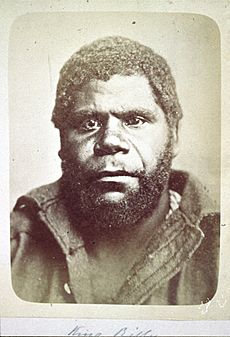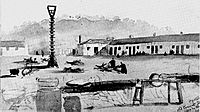William Lanne facts for kids
William Lanne (born around 1835 – died March 3, 1869) was an Aboriginal Tasmanian man. He was also known as King Billy or William Laney. He is remembered as the last "full-blooded" Aboriginal man in the colony of Tasmania.
William Lanne's Early Life and Whaling Adventures
William Lanne was born around 1835. In 1842, he was the youngest child in the last family moved from Cape Grim to the Aboriginal camp at Flinders Island. He was taken there by George Augustus Robinson. William was given his English name at Flinders Island, and it stayed with him. He was the only one of his family to survive his time on Flinders Island.
In 1847, he moved to Oyster Cove, Tasmania. He was sent to an orphanage in Hobart until 1851, when he returned to Oyster Cove. In 1855, the government told all strong men from Oyster Cove to find work outside the settlement. William Lanne then started working as a whaler. He joined the Tasmanian whaling and sealing industry.
When he was not at sea, William often stayed in hotels in Hobart Town with his shipmates. He worked on many whaling ships, like the Aladdin, the Jane, the Runnymede, and the Sapphire. These ships sailed in the Southern, Indian, and Pacific Oceans. Many pictures of William Lanne show him in his whaling clothes. This shows he was proud to be a seaman.
William Lanne was known for being good-humoured and well-spoken. People in Hobart admired him. In 1864, he wrote to government officials to ask for better living conditions for the women at Oyster Cove. In 1868, he was a special guest at the Hobart Regatta. There, he met the Duke of Edinburgh. The governor even introduced him as the "King of the Tasmanians."
William Lanne died on March 3, 1869. He was about 34 years old. He passed away two weeks after returning from a whaling trip. He died from a sickness that included cholera and dysentery.
William Lanne's Remains and Their Story
After William Lanne died, his body became part of a disagreement. Two groups, the Royal College of Surgeons of England and the Royal Society of Tasmania, argued over who should have his remains for scientific study.
The people of Hobart and other sailors buried his body. However, it was later dug up for an investigation. After this, his remains were lost.
William Lanne's Lasting Legacy
William Lanne's name is thought to be the origin of the "King Billy Pine." This tree is also called Athrotaxis selaginoides. It is a native Tasmanian tree. Today, it is an endangered species, meaning it is at risk of disappearing. It is threatened by climate change.



